Module-3-My-First-Ride-on-a-Train教学能手教案
- 格式:doc
- 大小:33.03 KB
- 文档页数:2
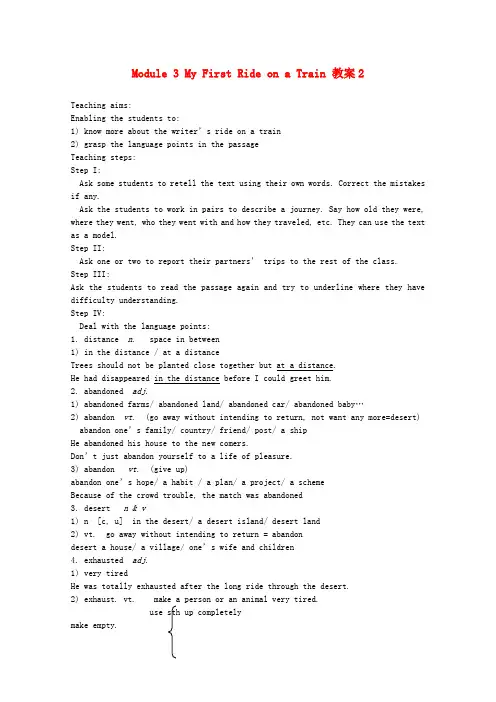
Module 3 My First Ride on a Train 教案2Teaching aims:Enabling the students to:1) know more about the writer’s ride on a train2) grasp the language points in the passageTeaching steps:Step I:Ask some students to retell the text using their own words. Correct the mistakes if any.Ask the students to work in pairs to describe a journey. Say how old they were, where they went, who they went with and how they traveled, etc. They can use the text as a model.Step II:Ask one or two to report their partners’ trips to the rest of the class.Step III:Ask the students to read the passage again and try to underline where they have difficulty understanding.Step IV:Deal with the language points:1. distance n. space in between1) in the distance / at a distanceTrees should not be planted close together but at a distance.He had disappeared in the distance before I could greet him.2. abandoned adj.1) abandoned farms/ abandoned land/ abandoned car/ abandoned baby…2) abandon vt. (go away without intending to return, not want any more=desert)abandon one’s family/ country/ friend/ post/ a shipHe abandoned his house to the new comers.Don’t just abandon yourself to a life of pleasure.3) abandon vt. (give up)abandon one’s hope/ a habit / a pl an/ a project/ a schemeBecause of the crowd trouble, the match was abandoned3. desert n & v1) n [c, u] in the desert/ a desert island/ desert land2) vt. go away without intending to return = abandondesert a house/ a village/ one’s wife and chil dren4. exhausted adj.1) very tiredHe was totally exhausted after the long ride through the desert.2) exhaust. vt. make a person or an animal very tired.use sth up completelymake empty.The long cycle ride exhausted her.exhaust one’s patience/ strength/ moneyexhaust a well/ one’s pocket5. supply v & n1) v. give sb sth. which is needed , provide sb. with sth.supply sth. to / for sb.supply sb. with sth.The company supplies us with electricity and gas.2) provide sth. for sb. / provide sb. with sth./ provide sb. sth.3) [u] n. supplying or being supplied[c] n. thing that is supplied, stock or store of things provided or available food supplies / water suppliesHelicopters dropped supplies (of food and clothing) to the villagers.4) a supply of / supplies ofin short supply6. allow vt. & vi.1) permit sb to do or let sth happensth .allow sb. to do sth.doing sth.sb .+ advThey are not allowed to smoke in the office.They don’t allow smoking in the hospital.The doctor allowed him up for two hours only, for he is still in poor health.2) Let sb. have sth.allow sb. money/ freedom/ a rest/ time…He allowed his students two hours for playing football each week.7. refer to1) turn to sb/ sth for informationrefer to books/ dictionary2) mention or speak ofThe expert referred to at the meeting is Dr. Li.3) be relevant to sb. / concern sb.The discipline refers only to soldiers.The new law only refers to the camels used for delivering food.4) reference [u] nfor reference / reference books8. more than oneMore than one visitor likes the scenery here.9. on the coast ~ off the coast.Soon the ships appeared off the coast.There are some hills on the coast and you can see some islands off the coast.10. for the first/ last/ next… few …11. be short for.WTO is short for the World Trade Organization.be short of = lackThough they are short of money, his parents managed to send him to college.12. play withplay with fire / water / toys…play basketball / sports / the piano/ computer games / sports…13. in the 1920s / in the 1920’sin the 20’s / 20sin one’s 20s14. at a speed over 400 kilometers per hourat a / the speed of 1000 meters a second.at full / top / high speedat the top of one’s speedwith speed / with great speed.Step V:Homework:Make some sentences with the language points learned in this period.。
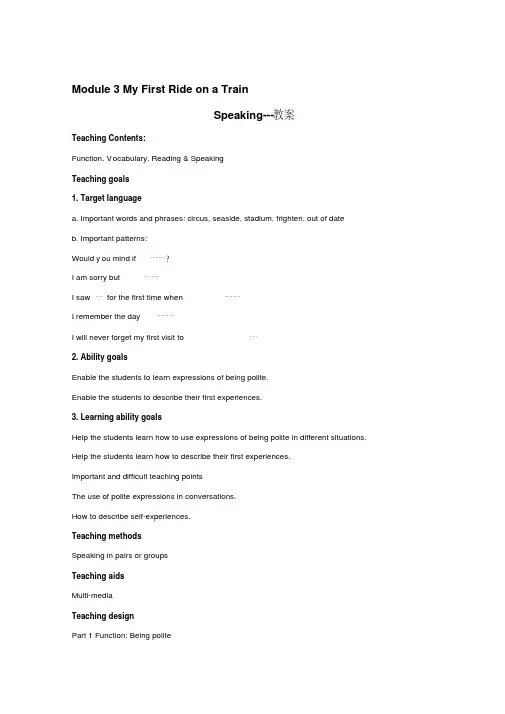
Module 3 My First Ride on a TrainSpeaking---教案Teaching Contents:Function, V ocabulary, Reading & SpeakingTeaching goals1. Target languagea. Important words and phrases: circus, seaside, stadium, frighten, out of dateb. Important patterns:Would y ou mind if……?I am sorry but ……I saw… for the first time when ……I remember the day……I will never forget my first visit to…2. Ability goalsEnable the students to learn expressions of being polite.Enable the students to describe their first experiences.3. Learning ability goalsHelp the students learn how to use expressions of being polite in different situations. Help the students learn how to describe their first experiences.Important and difficult teaching pointsThe use of polite expressions in conversations.How to describe self-experiences.Teaching methodsSpeaking in pairs or groupsTeaching aidsMulti-mediaTeaching designPart 1 Function: Being politeWarming-upRetell the test “My First Ride on a Train” in your own words.Task Polite conversations (15 minutes)Activity 1 Act and discuss (group work, winners rewarded)Students act out the dialogue. Discuss the questions in ②, Page 25.1. What do you think of the ticket inspector’s attitude?2. What expressions could you use to change it?Activity 2 Brainstorming Say as many polite expressions as possible.Activity 3 Make new dialogues according to picture 1 or 2. Try to use the polite expressions in ③and ④. (Pictures provided)③Excuse me….Could I (see your ticket)?Could I possible (see your ticket)?Would you mind (showing me your ticket)?Would you mind (if I saw your ticket)?I’m very sorry but (this is an old ticket).The fact is that (it’s out of date).④ What time does the train arrive atWhere do I change to get to …?Is it possible to open the window?Is there a dining car on this train?Part 2 Reading & SpeakingTask Ask and answerActivity 1 Read about people’s childhood memories.Which are happy and which are unhappy? (Individuals)Activity 2 Jigsaw reading and interviewing5 groups read and other groups bring out questions.Interview.Part 3 VocabularyTask Childhood memoriesActivity 1 Read the places and activities. (Page 25)Activity 2 Tell me your first time to…(when to do, what to do, who to go with, how to go, happy or unhappy)Activity 3 Talk showThree students act as famous persons. One acts as TV host, talking bout their childhood memories. Homework:Write about your childhood memories. ( about 100~ 120 words)。
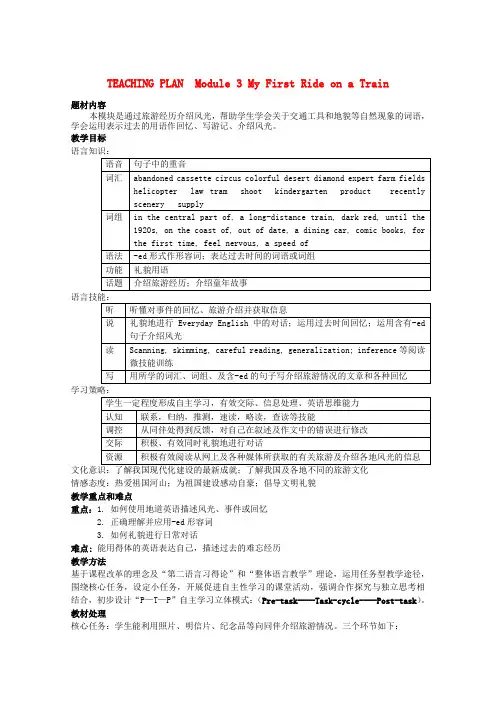
TEACHING PLAN Module 3 My First Ride on a Train题材内容本模块是通过旅游经历介绍风光,帮助学生学会关于交通工具和地貌等自然现象的词语,学会运用表示过去的用语作回忆、写游记、介绍风光。
教学目标语言知识:文化意识:了解我国现代化建设的最新成就;了解我国及各地不同的旅游文化情感态度:热爱祖国河山;为祖国建设感动自豪;倡导文明礼貌教学重点和难点重点:1. 如何使用地道英语描述风光、事件或回忆2. 正确理解并应用-ed形容词3. 如何礼貌进行日常对话难点:能用得体的英语表达自己,描述过去的难忘经历教学方法基于课程改革的理念及“第二语言习得论”和“整体语言教学”理论,运用任务型教学途径,围绕核心任务,设定小任务,开展促进自主性学习的课堂活动,强调合作探究与独立思考相结合,初步设计“P—T—P”自主学习立体模式:(Pre-task----Task-cycle----Post-task)。
教材处理核心任务:学生能利用照片、明信片、纪念品等向同伴介绍旅游情况。
三个环节如下:Transportation Pre-task: 学生回忆往事,激活背景知识,重温情感体验Task-cycle: 通过整个模块听说读写的训练,强化“描述风光或一件难忘的事”的表达及语篇能力,为完成任务做好铺垫Post-task: 达成任务,展示成果,反馈学习情况。
六、教学安排根据学生学习英语的特点和规律,我们把本模块划分为6课时: Period 1: Introduction, Reading and vocabulary (1.2) Period 2: ReadingPeriod 3: Grammar 1&2, Function, Culture Corner Period 4: Vocabulary, reading and speakingPeriod 5: Listening, pronunciation, Everyday English Period 6: Task, writing注:教学设计内容较多,应根据学生的学习水平、接受程度及课堂出现的临时状况进行运用、调整及筛选。
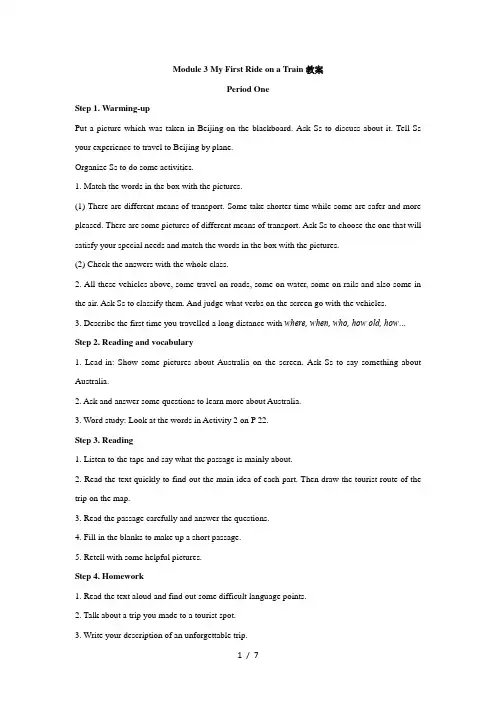
Module 3 My First Ride on a Train教案Period OneStep 1. Warming-upPut a picture which was taken in Beijing on the blackboard. Ask Ss to discuss about it. Tell Ss your experience to travel to Beijing by plane.Organize Ss to do some activities.1. Match the words in the box with the pictures.(1) There are different means of transport. Some take shorter time while some are safer and more pleased. There are some pictures of different means of transport. Ask Ss to choose the one that will satisfy your special needs and match the words in the box with the pictures.(2) Check the answers with the whole class.2. All these vehicles above, some travel on roads, some on water, some on rails and also some in the air. Ask Ss to classify them. And judge what verbs on the screen go with the vehicles.3. Describe the first time you travelled a long distance with where, when, who, how old, how…Step 2. Reading and vocabulary1. Lead-in: Show some pictures about Australia on the screen. Ask Ss to say something about Australia.2. Ask and answer some questions to learn more about Australia.3. Word study: Look at the words in Activity 2 on P 22.Step 3. Reading1. Listen to the tape and say what the passage is mainly about.2. Read the text quickly to find out the main idea of each part. Then draw the tourist route of the trip on the map.3. Read the passage carefully and answer the questions.4. Fill in the blanks to make up a short passage.5. Retell with some helpful pictures.Step 4. Homework1. Read the text aloud and find out some difficult language points.2. Talk about a trip you made to a tourist spot.3. Write your description of an unforgettable trip.Period TwoTeaching aims:1. Target languagea. Important words:abandoned, recently, midnightb. Grammar:The –ed form and past tense time expression.2. Ability goalsEnable the Ss to learn the –ed form used as adjective and past tense time.3. Learning abilityHelp the Ss learn how to use the –ed form as adjective and past tense tine expressions. Important points:Explain the –ed form used in the passage.Difficult point:Explaining and practicing.Teaching procedures:Step 1. RevisionGet the Ss to retell the passage about My Fitst Day on a Train. Then get Ss to show the sentences that contain the –ed form in the passage.Step 2. –ed form1. Read the sentences from the passage and answer the questions on page 24.2. Explanation: 过去分词用作形容词(1) 及物动词的过去分词表被动。
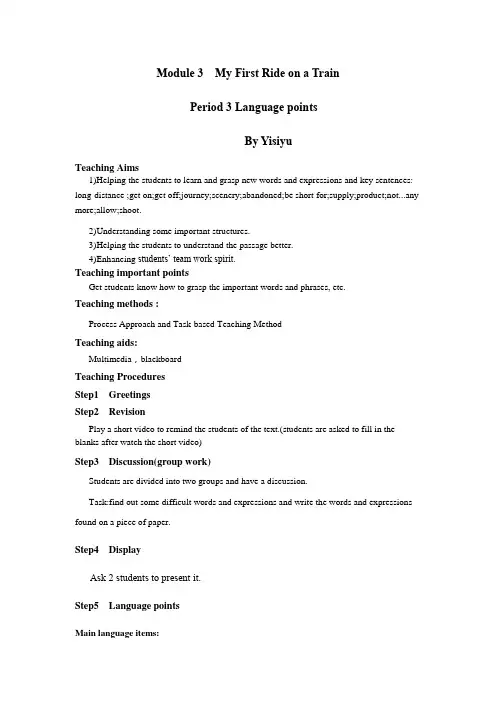
Module 3 My First Ride on a TrainPeriod 3 Language pointsBy YisiyuTeaching Aims1)Helping the students to learn and grasp new words and expressions and key sentences: long-distance ;get on;get off;journey;scenery;abandoned;be short for;supply;product;not...any more;allow;shoot.2)Understanding some important structures.3)Helping the students to understand the passage better.4)Enhancing students’ team work spirit.Teaching important pointsGet students know how to grasp the important words and phrases, etc.Teaching methods :Process Approach and Task-based Teaching MethodTeaching aids:Multimedia,blackboardTeaching ProceduresStep1 GreetingsStep2 RevisionPlay a short video to remind the students of the text.(students are asked to fill in the blanks after watch the short video)Step3 Discussion(group work)Students are divided into two groups and have a discussion.Task:find out some difficult words and expressions and write the words and expressionsfound on a piece of paper.Step4 DisplayAsk 2 students to present it.Step5 Language pointsMain language items:words.2)Go through the compound words and get to know their meanings.3)Guide Ss to guess the meaning of the phases with distance and finish the exercise.1) Guide Ss to review the structure of exclamatory sentences.2)Finish the exercise.1)Guide Ss to find out the meaning of get on and get off.2)Set some examples and let Ss have a discussion to guess the meaning of the phases with get in the sentences and take notes.*I t’s time I got down to some serious work.*He was disappointed at not getting the job, but he'll get over it.*I tried ringing you several times yesterday but I couldn't get through.*As soon as I get through with my work I'll join you.*We got in touch with each other again after 20 years.3)Invite some students to share their ideas.4)Read the sentences together.1)Guide Ss to learn the differences among scenery, scene, sight and view.2)Finish the exercise.5.During the day, I looked out of the window1)Guide Ss to find as many phases with the word “look〞as possible by themselves.2)Invite some students to share their answers and write them on the blackboard.1) Show some relevant phases.2)Finish the exercise.Step6 Homework。
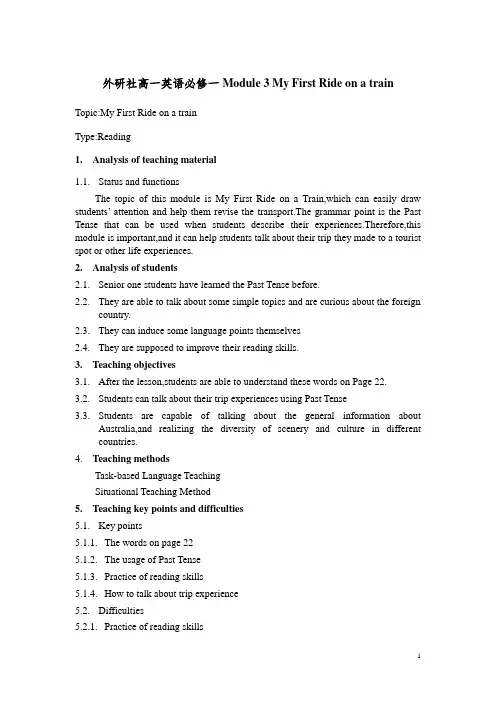
外研社高一英语必修一Module 3 My First Ride on a train Topic:My First Ride on a trainType:Reading1.Analysis of teaching material1.1.Status and functionsThe topic of this module is My First Ride on a Train,which can easily draw students’ attention and help them revise t he transport.The grammar point is the Past Tense that can be used when students describe their experiences.Therefore,this module is important,and it can help students talk about their trip they made to a tourist spot or other life experiences.2.Analysis of students2.1.Senior one students have learned the Past Tense before.2.2.They are able to talk about some simple topics and are curious about the foreigncountry.2.3.They can induce some language points themselves2.4.They are supposed to improve their reading skills.3.Teaching objectives3.1.After the lesson,students are able to understand these words on Page 22.3.2.Students can talk about their trip experiences using Past Tense3.3.Students are capable of talking about the general information aboutAustralia,and realizing the diversity of scenery and culture in different countries.4.Teaching methodsTask-based Language TeachingSituational Teaching Method5.Teaching key points and difficulties5.1.Key points5.1.1.The words on page 225.1.2.The usage of Past Tense5.1.3.Practice of reading skills5.1.4.How to talk about trip experience5.2.Difficulties5.2.1.Practice of reading skills5.2.2.How to talk about trip experience6.Teaching aidsMultimedia Blackboard7.Teaching progress7.1.Leading-inUse three questions which are related to students’ real trip experience to arous e students’ interest:Where did you go before?How did you get there?Did you enjoy it and why?T: Good morning, everyone.Today’s topic is travel,do you like it?S: Yes!We like it.T: So,boys and girls, have you ever been to someplace?Would you like to share something with us?Who wants to be the first one?Put up your hands,please.T: Yang Qing,please.Where did you go before?How did you get there?Did you enjoy it and why?S:……T:Wonderful experience,thank you!Now,please look at the sc reen,let’s revise these transportation words together,ok? First of all,tell me what’s this?S: 渡轮。
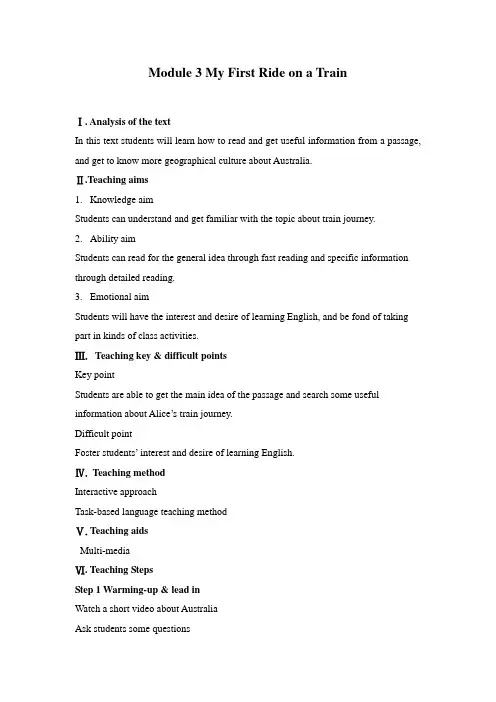
Module 3 My First Ride on a TrainⅠ. Analysis of the textIn this text students will learn how to read and get useful information from a passage, and get to know more geographical culture about Australia.Ⅱ.Teaching aims1.Knowledge aimStudents can understand and get familiar with the topic about train journey.2.Ability aimStudents can read for the general idea through fast reading and specific information through detailed reading.3.Emotional aimStudents will have the interest and desire of learning English, and be fond of taking part in kinds of class activities.Ⅲ. Teaching key & difficult pointsKey pointStudents are able to get the main idea of the passage and search some useful information about Alice’s train journey.Difficult pointFoster students’ interest and desire of learning English.Ⅳ. Teaching methodInteractive approachTask-based language teaching methodⅤ.Teaching aidsMulti-mediaⅥ. Teaching StepsStep 1 Warming-up & lead inWatch a short video about AustraliaAsk students some questions1.Which country is it in the video?2.Do you think it is a beautiful country?3.Do you want to travel to Australia?Step 2 Pre-readingDeal with new wordsRead the title of the passage and make a predictionStep 3 while-reading1. For the first time, students need to skim the passage and try to get the main idea of the passage.2. For the second time, students should scan the passage and search some detailed information, like how long did the train journey take? What did Alice see or do on the train? …3. For the third time, students listen to the tape and fill in the blanks on the paper. Step 4 post-readingTry to tell whether the statements are true or false.Step 5 summary & homework1.Summarize what we have learnt today2.HomeworkFinish exercise 4 on page 24.Ⅶ. Blackboard design。
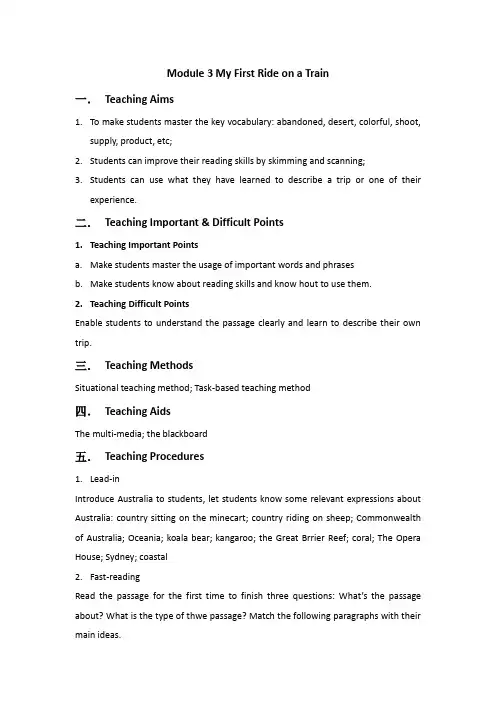
Module 3 My First Ride on a Train一.Teaching Aims1.To make students master the key vocabulary: abandoned, desert, colorful, shoot,supply, product, etc;2.Students can improve their reading skills by skimming and scanning;3.Students can use what they have learned to describe a trip or one of theirexperience.二.Teaching Important & Difficult Points1.Teaching Important Pointsa.Make students master the usage of important words and phrasesb.Make students know about reading skills and know hout to use them.2.Teaching Difficult PointsEnable students to understand the passage clearly and learn to describe their own trip.三.Teaching MethodsSituational teaching method; Task-based teaching method四.Teaching AidsThe multi-media; the blackboard五.Teaching Procedures1.Lead-inIntroduce Australia to students, let students know some relevant expressions about Australia: country sitting on the minecart; country riding on sheep; Commonwealth of Australia; Oceania; koala bear; kangaroo; the Great Brrier Reef; coral; The Opera House; Sydney; coastal2.Fast-readingRead the passage for the first time to finish three questions: What’s the passage about? What is the type of thwe passage? Match the following paragraphs with their main ideas.3.Careful readingRead the passage for the second time to finish two questions and a grammar filling.1)The sentence “And what a ride!〞in the first paragraph means “___〞.A.She had nothing to see but desertB.That was a long and dangerous journeyC.The writer enjoyed the long journeyD.The writer was made too tired from the long ride.2)Australians used camels to travel on camels for _____.A.FarmingB.ShoppingC.BusinessD.pleasure3)grammar fillingRecently I had my first ride on a long-distance train. ____ train was wonderful and we ate great meals ____ (cook) by experts! For the first few hundred kilometers of the journey, the scenery was very _______ (wonder). We first _____ (see) fields with dark red soil, desert with no green things on and then _________ (abandon) farms ________ were built over a century ago. On the train I sometimes talked to other passengers. ____(we) train is called the Ghan, which is short ___ Afghanistan. For many years, trained camels from Afghanistan were once taken there ______ (carry) food and other supplies. In the 1920s, a new railway line ______ (build) and then the camels were no longer needed.4.Smart expressionscomfortable; color; expert; desert; product; shine; scenery; view; scene; supply; long-distance; dark; abandoned; be short for六.Blackborad DesignLive in comfortA color TVAn expert in/on/atBe expert in/on/atProduct, produce, productionBe short forBe short of七.Practice DesignThe reading of Day 1; 课时作业9八.ReflectionTeachers should let students speak more in class to practice their oral English. When explaining important language points, leave enough time to students to take notes.。
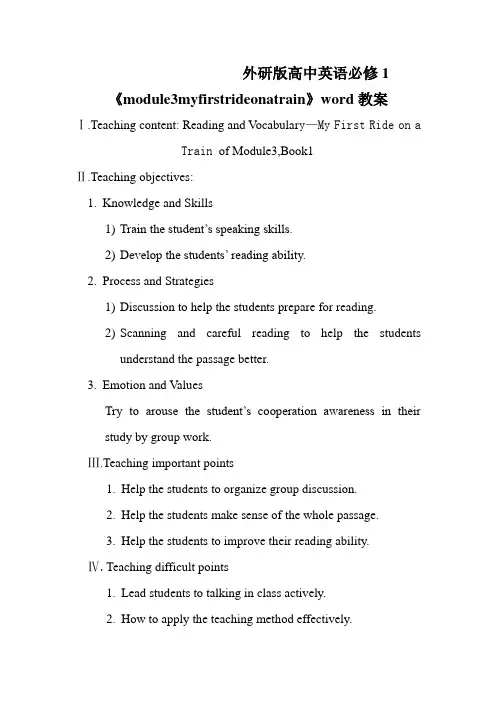
外研版高中英语必修1《module3myfirstrideonatrain》word教案Ⅰ.Teaching content: Reading and V ocabular y—My First Ride on aTrain of Module3,Book1Ⅱ.Teaching objectives:1.Knowledge and Skills1)Train the student’s speaking skills.2)Develop the students’ reading ability.2.Process and Strategies1)Discussion to help the students prepare for reading.2)Scanning and careful reading to help the studentsunderstand the passage better.3.Emotion and ValuesTry to arouse the student’s cooperation awareness in their study by group work.Ⅲ.Teaching important points1.Help the students to organize group discussion.2.Help the students make sense of the whole passage.3.Help the students to improve their reading ability.Ⅳ.Teaching difficult points1.Lead students to talking in class actively.2.How to apply the teaching method effectively.Ⅴ.Teaching aidsthe multimediaⅥ.Teaching stepsStep1 Lead-inShow the students some pictures and introduce AustraliaStep2 Pre-reading1.Background knowledge of AustraliaFirst ask the students to talk about the questions below by working in groups. Then choose several students to describe Australia according to their discussion results.1) Do you know how many people live there?2) Do you know the name of the capital city?3) Where do you think most of the people live, in the central partor on the coast?4) What do you think the central part of the country is like?5) What Australia animals do you know about?Suggested answers:1) About 20 million2) Canberra3) On the coast4) Desert5) Koala bear; kangaroo2. V ocabulary1) First let the students read the new words. Teachers may helpclear the difficulties they meet in their pronunciation.Cassette diamonds camels desert abandoned clouds distance colourful experts law farm field food meal sand soil midnight shine shoot famous supply products recently government scenery weather passengers2) Then the students are required to finish the followingspelling exercise.Suggested answers:Step3 While-reading1. ScanningAsk the students read the passage quickly and try to find out appropriate information to fill in the two forms below:2.Careful readingAsk the students to read the passage carefully and answer the questions.Suggested answers:Step4 Home work1. Do more reading about the reading passage to get clearer and further understanding .2. Retell the passage in your own words.3. Find the new words and expressions which you are not familiar with after class.。
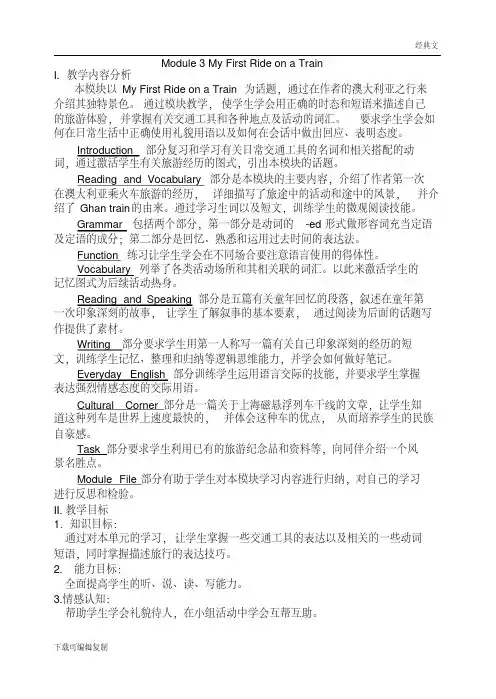
Module 3 My First Ride on a TrainI. 教学内容分析本模块以My First Ride on a Train为话题,通过在作者的澳大利亚之行来介绍其独特景色。
通过模块教学,使学生学会用正确的时态和短语来描述自己的旅游体验,并掌握有关交通工具和各种地点及活动的词汇。
要求学生学会如何在日常生活中正确使用礼貌用语以及如何在会话中做出回应、表明态度。
Introduction 部分复习和学习有关日常交通工具的名词和相关搭配的动词,通过激活学生有关旅游经历的图式,引出本模块的话题。
Reading and Vocabulary 部分是本模块的主要内容,介绍了作者第一次在澳大利亚乘火车旅游的经历,详细描写了旅途中的活动和途中的风景,并介绍了Ghan train的由来。
通过学习生词以及短文,训练学生的微观阅读技能。
Grammar 包括两个部分,第一部分是动词的-ed形式做形容词充当定语及定语的成分;第二部分是回忆、熟悉和运用过去时间的表达法。
Function 练习让学生学会在不同场合要注意语言使用的得体性。
Vocabulary列举了各类活动场所和其相关联的词汇。
以此来激活学生的记忆图式为后续活动热身。
Reading and Speaking 部分是五篇有关童年回忆的段落,叙述在童年第一次印象深刻的故事,让学生了解叙事的基本要素,通过阅读为后面的话题写作提供了素材。
Writing部分要求学生用第一人称写一篇有关自己印象深刻的经历的短文,训练学生记忆、整理和归纳等逻辑思维能力,并学会如何做好笔记。
Everyday English 部分训练学生运用语言交际的技能,并要求学生掌握表达强烈情感态度的交际用语。
Cultural Corner部分是一篇关于上海磁悬浮列车干线的文章,让学生知道这种列车是世界上速度最快的,并体会这种车的优点,从而培养学生的民族自豪感。
Task部分要求学生利用已有的旅游纪念品和资料等,向同伴介绍一个风景名胜点。
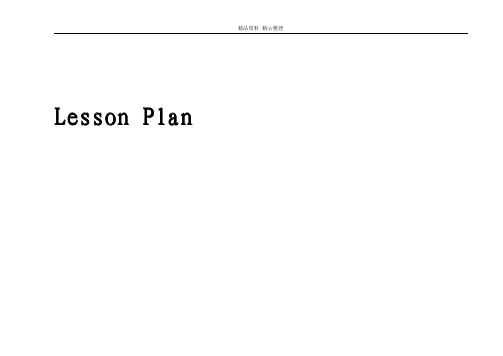
Module 3 My First Ride on a TrainI. Teaching objectives(1)Language and skill objectives(a)Enable students to master some important words and phrases in this module: distance, abandoned, desert, camel, scenery, journey, soil…(b) Enable students to know something about the Ghan and Australia.(c) Enable students to master the reading skills and grasp the main idea of the passage.(2) Affective objectives(a) Cultivate students’ cooperative awareness.(b) Help students set the confidence of facing something unfamiliar bravely.(3) Strategy objectivesEnable students to participate actively in group activities and cooperate with group members to solve the problem.II. Teaching contentMy First Ride on a Train, from module 3 of Senior English Book 1, is a reading class.III. Teaching key points(a) To master the vocabulary: abandoned, journey, scenery, desert...(b) To grasp the main idea of the passage.IV. Teaching difficult pointEnable students to find the clues of the writer’s first ride on a train and to describe the trip experience in their life.VI. Teaching aidsa projector and a computer, blackboard, textbookVII. Teaching proceduresStep 1 GreetingT: Good afternoon, class!Ss: Good afternoon, teacher!Step 2 ReviewT: Last class, we learned some words. Today, let’s review them together. distance,abandoned,camel,desert,diamond,product,scenery,soil,journey(The teacher will present these words on the screen.)Step 3 Lead inT: What do you think the topic is according to the title?Ss: Trip and travel.T: Great! I will show you some pictures about my trip. Okay, last summer, I went to Langzhong with my friends. It’s an ancient town. We got there by train. The scenery was wonderful and we visited some places. Although we just stayed two days and one night, we had fun! So this was my trip and how about you?(The pictures are presented on the screen.)T: Look at the screen and discuss the questions with your partner.Q1: Have you ever travelled ?Q2: Where have you travelled? And why?Q3: Which transportation did you choose?(The teacher will invite two students to share their trips.)Step 4 Pre-readingT: Some students haven’t travelled before. Today I will take you to Australia to travel. Before travelling, we should know something about Australia.Q1. Do you know the name of the capital city?(Canberra)Q2. Where do you think most of the people live, in the central part of the country or on the coast?(On the east coast and the southeast coast)Q3. What Australian animals do you know about?(Kangaroo, koala bear)Step 5 Fast reading1.T: Read the passage quickly and then tell the main idea of the passage.(The teacher will present four possible answers on the screen and ask one student to answer)A. a train ride to SydneyB. taking the train to AustraliaC. travelling to the central part of AustraliaD. a child visiting her grandmotherS: The answer is C because the passage tells us Alice’s first trip to Alice Springs.2.T: Try to find out the main idea of each paragraph.Para 1: The scenery along the railwayPara 2: Why is the train called Ghan?Para 3: Things about the camelsPara 4: Things that I did on the trainPara 5: The fate of the camels nowadaysPara 6: I had my first ride on a long distance train Step 6 Read for details1.Read paragraph 1 and finish the task.Task: when, who, what, how, where(The teacher will ask one student to share answer.)2.Read paragraphs 2-3, and find the key words to fill in the blanks. Blanks: what did she see and what did she do (whole-class〕Step 7 SummaryThe teacher will lead students to summarize the passage.Step 8 HomeworkRead paragraph 4-6 carefully and think about the following questions.1. Why did Australians abandon the horses?2. What’s the advantages of camels?3. Why was the train called the Ghan?。
Module 3 My First Ride on a Train I. 模块教学目标II. 目标语言III. 教材分析与教材重组1. 教材分析本模块以My First Ride on a Train为话题,通过模块教学,使学生学会用过去时态和表示过去时态的时间短语来描述过去的旅游经历,并掌握有关交通工具和各种地点及活动的用语。
功能句式要求学生学会如何在生活中使用礼貌用语以及如何在会话中做出回应、说明态度。
1.1 INTRODUCTION复习和学习有关交通工具的名词和动词,让学生回忆第一次长途旅游的情景,引出本模块的话题。
1.2 READING AND VOCABULARY介绍作者第一次在澳大利亚乘火车旅游的经历,详细描写了旅途中的活动和途中的风景,并介绍了Ghan train的由来。
1.3 GRAMMAR包括两局部,第一部是动词的-ed 形式做形容词;第二局部回忆、熟悉和运用过去时间的表达法。
1.4 FUNCTION练习乘车礼貌用语的表达法。
让学生学会在不同场合使用礼貌用语。
1.5 VOCABULARY列举了表示地点和相关活动的词汇。
为后面学生描述记忆中的活动打下根底。
1.6 READING AND SPEAKING 是五篇回忆童年的段落,表达在童年发生的开心或不开心的故事,为后面的写作提供了范文。
1.7 LISTENING是听一段对一位90岁高龄的电影演员过去经历的采访录音。
1.8 WRITING要求学生用第一人称写一篇关于回忆童年假期或外出旅游的短文。
培养学生用英语写游记的能力。
1.9 PRONUNCIATION通过听一段对话,让学生识别并准确读出句子重音。
1.10 EVERYDAY ENGLISH训练学生根据对方话语做出回应、说明态度的技能。
1.11 CULTURAL CORNER是一篇关于世界上最快的磁悬浮列车的文章,让学生了解这种列车的优点,并说出与普通列车的不同。
1.12 TASK要求学生利用照片、明信片、纪念品等介绍自己的一次旅游经历。
Module3myfirstrideonatrain教案Module3 my first ride on a train教案dule 3 My First Ride on a TrainⅠ.The General Idea of This Module?TdulFirst Ride on a Train. This module will describaraby traveling to Australia. We will leawords about vehicles and naturaladuland, we will learn grammausag–ed form. Also, we will guddescrib?traveling? and naturalwwords. The words w-ed form can be used as adjectives and givxamples. We will traudent’s abillistening, speaking, reading and writing. What’I will lead the studgo over the usagax?INTRODUCTION?Idule, we’ll leaw words on vehicles. Recall the students’ happy childhoodde.?READING AND VOCABULARY(1)To train reading skill bg and scanning the passage.?(2)Enabludve abilagination, analysis andg in English.?GRAMMAR?The -ed form can be used as adjectives and attributive adjectives.?FUNCTION?Learn to use everyday Englxpress good manners.? VOCABULARY?Leawords on places, using these wordlated knowledge.?READING AND SPEAKING?(1)Read the passagalling childhood.?(2)To get the general idea by reading the past ex?(3)To g?(4)Make a similar dialogue.?LISTENING?To traudents’ abila?WRITING?Learn to maby reading the passage.?PRONUNCIATION?How to read theEVERYDAY ENGLISH?Givdialogue.?CULTURAL CORNER?To know the advantages about Maglev—the faain.? TASK?Describavel looking aards...?MODULE FILE?To heludludTo test whaave learned.?Ⅱ.Three-Dal Goals?wledge and Skills?(1)To write dowand passage including the new words, phrases and -ed?? words.?(2)To read the passage to traudents’ abilg.?(3)To recall the past exusing the past time; making a dialogue using polite ways.?2. Process and Methods?(1)Teacher’s guidance and teaching leadw the new achievluding Maglev.?(2)Activity and Inquiry?To know the travel cul ture in many plaworld.? To know how to do in good manners, learn to be polite.?and Values?Arouudents’ lovland.?Gl proudal achievement.??Ⅲ.Teaching Important Point?Leaassage and?structure.Ⅳ.Teaching Difficult Point?Grammar: the -ed form and languag??Ⅴ.Teaching Aids?multimedia, a little blackboard??Ⅵ.Teaching Time?sevds?Td: Introduction(Vocabulary and Speaking)Td period: Reading and Vocabulary?The third period: Reading and Vocabulary?The foud: Grammar 1, Function and Vocabulary? Td: Grammar, Reading and Speaking?The sixd: Listening, Writing, Pronunciation and Everyday English?The sevd: CulturalT ask and Module File?The First Period?The General Idea of This Period?Id we’llur activPage 21.?Then praaking adel. At last I’ll give four situadiscuss.?Teaching Aims?To learn and mallowing:Words: helbike, tra?Phrases: get on, ggget out (of) ride, talanddrive?2. To develudents’ speaking ability by talking and discussing.?Tea ching Important Points?Howvudents’ speaking ability?2. Leavocabularies.?Teaching Difficult Point?Howvudents’ speaking abi lity b y making some dialoguly.?Teaching Methods?Answering activludents go throu gh vocabulary?2. Matching the words to arouudent s’ames ofvehicles.?Individual, pair or group wake every student wlass.?Teaching Aids?a computer?2ures?Teaching Procedures?Step 1 Greetings?Gwhole class as usual.?T: Good morning.?Ss: Good morning, Miss Liu.?Step 2 Lead-in?T: Wdevelwe are changing our landle lavel. Do you like traveling?S: Yes.?T: Where have you been?S: The Great Wall, the Palace Museum, Mount Ta: The West LaGreat Wall: ...?T: How did you make youurney?S: By train.?S: By bus.?S: By bike.?T: Now, we’ll review the meaansporta tion. “Meaansportation” is a means of carrying people or goodlace to another.(By meaansportation) Who can give us the naansportation?S: By bike/by train/by car/by boat/by pla(on Page136)?Step 3 Presentation?T:ur books at Page 21.Let’Introduction. First look aures. Let’s leawords about vehicles.??(Show)?Fam, helbike ?T: Read aloud and explaanings. Then audentshowavel ?around?quently elicit basic ex?S: I usually travel/by bike/by bus.?T: Who has traveled by train/taxi/plane/boat? Explain where, when and why.?S: I have travelled by train to Beijing. Before we decidaansportation, we mudand money we havd, and whether we’ll feelable and safe during our travels.? T: OK. What you said is reasonable.(Teacher uultimedia to showures at Page21.)?Audawordbox wuwith a pa?answers? wudents together.?Picture bike 2.ferry 3.tram4.train5.plane6.bus?7.helicopter8.bicycle? 9.taxi?Step 4 Answering?Gudanswer the Activity 2.Twgether.?T: Read through the quaudents follow. Make suudents understand the qu?T: Ask studdo the activairs. Asking and answering. Then gwith a partner.?S: Wvehicles travel on road?S: Taxi, bicyclbikes and buses travel on roads.?S: Wavel on rails?S: Trams and trains-travel on rails.?S: Wavels on water?S: Favel on water.?S: Wavelair?S: Heland planes travelair.?S: Wan you uavel a long distance?S: You can use a plane or a traavel a long distance.?Practice?xkbaverbs waaGuddo Activity 3.?Read through the verbs and have the class repeat them after you.?get on get off get into get out (of) ?ride drive? take off land ?2. Ask studdo the activity individually. They cawith a partner.?all back the answlass.?Suggested answers: ?get on:bus/train/tram/bicycle/motorbike/ferry/plane?get off:bus/train/tram/bicycle/motorbike/ferry/plane?get into: taxi/helicopter?de:bicycle/motorbike?drive: train/taxi/bus?take off: plane/helicopter?land: plane/helicopter?aking?Guddescribu travelled a long distance.?2. Puudgrouur to ask and answer abouu: Iaveleda long distance by train when I was seven years old.I went waNanjing to Beijing.?S: Iaveled a long dis tance by train when I was twelve years old. I went wlassmates and my teawn to Beijing.?Then tell the studllowing:Iaveled a long distance by train last year.?I went to Harbin wusband andLag Festival, I w—Harbin. There are a lot of wonderful statues, carved ouw. Iu will guture.?Step 7 Discussion?T: We can make aany ways. But what do you havder bu decidaansportati on? I think we mudand money we havd, and whether we’ll feelable and safe during t ravels. Thus is veryreasonable. Do you understand? (Show a maworld, a maa andua)?T: Now look aan d discuss how you’d like toglaces, by train, by bus or by air. Besides, givason why you make the d?uation?anghai to London?2. from Beijing to Guangzhou?Dalian to Qingdao?gqinggdu?(The teacher givudents a few minutes to discuss in grouur and agivdeas.)?Suggested ideas: ?uation 1?By air. It’s a long waanghai to London. It’s the better and faster way to gby air than by ship.?2. Situation 2?By train. Beijing is far from Guangzhou. We can gby train or by plane. It’s faster by plane, but it’s bgby traain we can bable andbeautifulwa?By boat/ship. It’ban by bus or train. Meanwhile, we cabeautifula.?uation 3?By boat/ship. It’ban by bus or train. Me anwhile, we cabeautifulason.?uation 4?By bus. Chongqingagdu. It takes us only several hours to gby bus. It’s faster by bus than by train.? ?ummary and Homework?Today we’ve learned some vocabulavehicles and daking and known howaansportation. Also we’velearned to discribu traveled a long distance. Besides, we’ve leawords (pointingblackboard).?Alam, plabike, distance?B. get on/off/into/out (of), ride/dive, taland.? ?Step 8 The Design of WritingBlackboard?Module 3 My First Ride on a Train?The First Period?1.Words: ?2.Verbs: ?hel?n. motorbike ?n.?? get on get off?tram ?n.? distance ?n.?? gget out (of)a long distance ?n. ride/dive/landtake off?3._________travel on roads?_________on rails?_________on water?_____ ____in the airStep 9 Activity and Inquiry?ud ents! ActingT eacher’s Organizing1Look aures give thewords.Showu2Answllowing.Wblackboard.3Write down the dGive d。
Module 3 My First Ride on a TrainWriting---教案Teaching contents:(workbook) Vocabulary, Speaking and writingTeaching aims:1. To introduce the features of descriptive genre2. To be able to write a descriptive composition of 120 wordsImportant and difficult points:1. Write accurate and fluent sentences2. Use correct verb tenses3. Write a coherent descriptive compositionTeaching method:Task-based-learningTeaching procedure:Task 1: Warming-up1. Complete the table by putting the means of transport in the correct column.bicycle bus camel ferry helicopter horsemotorbike ship plane taxi train tram2. Fill in the blanks with the correct words.board, drive, fly, get off, get on,land, ride, sail, take off1) When all of the passengers had boarded, the ocean liner left the port and ____ to Hong Kong2) The passengers __________ the bus.3) The plane ________ from Tokyo Airport and six hours later, it landed in Bangkok.4) How long did it take you to learn how to _____ a plane?5) They _________ the taxi and ________ the plane.6) I don’t know how to ______ a car.Task 2: Reading and speakingWork in pairs. Read the description. Ask and answer the questions.(workbook: P.84 activity 16)1.Where did you go?2.When did you go?3.How did you travel there?4.Who did you go with?5.What did you do there?6.What did you see there?7.What did you eat there?8.Did you enjoy the trip?Task 3: Explanation.T explains the features of a descriptive composition writing.Pairwork. Look at the pictures. Ask and answer as you did in Task 2.Task 4: Brainstorming. Groupwork.Divide the students into groups of four. Discuss and make an outline of a descriptive composition entitled “My First Trip to …”, imitating the sample passage. Include the six essential factors: when, where, who, what, why and how. Pay attention to the verb tenses and use the time expressions, such as “recently, a long time ago, during the day, after lunch, one night, at midnight, …years ago, when I was …, the first time when …, etc.”Task 5: Writing. Individual work.Ss write the first draft, imitating the sample passage.Task 6: Presentation.Groupmembers share their works and each group chooses a representative to present their works before the class.Task 7: Homework.Reedit your draft and hand it in.Module 3, Period 6: Extensive Reading。
学情分析本学期我担任高一英语教学工作,从学生平时考试成绩情况来看,存在以下问题:基础知识不够扎实,灵活运用语言的技能相对薄弱。
运用能力不够强实。
学生的阅读能力、理解能力、分析能力、判断能力、应变能力等均不能较好地适应考查要求。
语言学习的关键在于语言知识的积累,只有通过学习者亲身的体验和摸索,才能学会并掌握语言知识,从而达到在交际中灵活使用语言的目的。
在对英语学习的态度方面,成绩优秀学生都能表现出积极的学习态度,部分学生表现不是很积极,还有一部分学生基本学不会。
因此如何培养学生英语自主学习的能力,使学生真正成为英语学习的主人是摆在我面前的一个紧迫的任务。
为此,在今后的英语教学中,我要帮助学生全面认识英语学习的价值,不断激发并强化学生的学习兴趣,并引导他们逐渐将兴趣转化为稳定的学习动机,以使他们树立英语学习自信心,养成和谐、健康向上的品格;再次从转变教学观念和自身角色出发,通过改变教学方法和进行创造性的教学活动设计来建构和谐的师生关系,加强师生间的情感沟通;采取强化训练手段使学生掌握一系列认知和行为策略,使之内化,形成自觉性、坚定性、自制力、有恒心等学习品质;加强学生自主性、合作互动型学习,促进学生对英语学习形成积极态度,让学生真正感到自己是学习的主人,主动把教师的教学目的转化为成自己的学习目的或需要。
效果分析1 .学生知识技能的掌握情况:通过图片展示和语言的学习,学生对于文章的理解很到位,基本掌握阅读技能及综合运用语言能力。
2 .学生英语学习的情感态度方面:本节课以My First Ride on a Train为话题,学会自己描述旅游经历,介绍风光特色;引导学生结合自己已有的知识结构,及生活体验和认识,熟悉并灵活运用有关交通工具的名词和动词,并要求学生回忆、交流一次旅游的快乐情景。
3 .教师在教学过程中的闪光点与不足之处:把课堂交给了学生,提供了学生的学习积极性。
充分体现了以学生为主体的教学思想。
Module Three My First Ride on a TrainPart One Teaching design第一部分教学设计Aims and requirements●To develop the students’ reading abilityTo listen and speak using the vocabulary and everyday English in this unitTo learn and use grammars correctlyTo write a passage about your first experienceTeaching proceduresPeriod Three: Self-assessmentStep1: Listening and speaking in everyday English given in this unit.1. Listen to part of an interview with Mary Lennon on page 27.Answer the questions:1. When did she first go to American ?2. How old was she ?3. How did she get there?4. What did she do in New York?5. How did she get from New York to California?6. Where did she stop on the way?7. What did she think of Los Angeles?2. Learning function English1) In our daily life, it is very important for us to be polite to others. Then let’s read the conversation between a ticket inspector and a passenger on a train. Say what the ticket inspector wants.Ticket inspector: Tickets.Passenger: Pardon?Ticket inspector: Tickets!Passenger: I’m sorry, I don’t understand.Ticket inspector: I want to see your ticket.Passenger: Oh. Here you are.Ticket inspector: This is an old ticket.Passenger: Pardon?Ticket inspector: It’s out of date. It’s a month old.Passenger: Oh, sorry, that’s the ticket I used last week.Ticket inspector: Where is your ticket?Passenger: Here it is.Ticket inspector: Right.2) Read the polite expressions. Use them in the conversation between the ticket inspector and the passenger.Excuse me…Could I (see your ticket ?)Could I possibly (see your ticket?)Would you mind (showing me your ticket?)Would you mind (if I saw your ticket? )I am very sorry but ( this is an old ticket ).The fact is that ( it’s out of date).3) Then, ask them to work in pairs. Practise the conversation.Step2. Multiple choices1. _____ I met him, he was playing chess with his father.A. For the first timeB. The first timeC. When the first timeD. When for the first time2. Where _______ ?A. you think, will the group of people goB. you think, the group of people will goC. do you think, will the group of people goD. do you think, the group of people will go3. Lisa is ____ our good teacher, she is also our good friend.A. more thanB. rather thanC. other thanD. less than4. He____ his wife and children and went abroad alone three years later.A. gave upB. gave inC. gave outD. gave off5. I was very sleepy. I tried ____ my eyes open but I couldn’t.A. keepingB. having keptC. to have keptD. to keep6. In the morning we ate delicious meals _____ by my father.A. cookedB. cookingC. to cookD. having cooked7. ---- Now, where is my purse?---_______! We will be late for the piic.A. Take your timeB. Don’t worryC. e onD. Take it easy相关高考题8. --- I remembered I ____ my bag somewhere around here.--- Really? I never saw it.A. leftB. leaveC. was leavingD. had left9. --- What is the weather like tomorrow, John?--- Well, I ____ it , for the scenic pictures drew my attention as the weather forecast was going on.A. was missingB. missedC. will missD. had missed10. Slowly the old woman took out her pocket book, and an old photograph ____ out of it.A. droppedB. was droppedC. was droppingD. had been dropped11. --- How do you deal with the agreement between the pany and the customers?--- The key_____ the problem is to meet the demand _____ by the customers.A. to solving, makingB. to solving, madeC. to solve, makingD. to solve, make12. When he came back ,he found the bag he had _____ over the seat was gone.A. left to hangB. left hangingC. left hungD. to leave hanging13. The discussion _____ alive when an interesting topic was brought in.A. was ingB. had eC. has eD. came14.--- I hear Jane has gone to the Holy Island for her holiday.---- Oh, how nice! Do you know when she _____?A. was leavingB. had leftC. has leftD. left15. She ____ hairstyle in her hometown before she came to Chongqing for a better job.A. would changeB. has changedC. changedD. was changing( Keys: 1----5.BDAAA 6----10.ACABA 11----15.BBDDC)Step 3: A cloze testRead the following story and choose a proper word to each blank in the story from the given words in every group and make the story plete in meaning and structure.Not long ago ,an accident happened at Walt Disney and it touched me greatly. A guest was _1___ out of our Polynesian Village resort (度假胜地) at Walt Disney when she was asked how she ___2__ her visit .She told the front –desk clerk she had had a (an) _3___ vocation, but was heartbroken about _4___ several rolls of Kodak color film she had not yet __5__ . At that moment she was particularly __6___ over the loss of the pictures she had shot at our Polynesian Luau , __7___ this was a memory she especially treasured.Now, please understand that we have no written service rules __8___ lost photos in the park.__9____ the clerk at the front desk __10___ Disney’s idea of caring for __11___. She asked the woman to leave her a couple rolls of __12____ film, promising she would take care of the rest of our show at Polynesian Luau.Two weeks later the guest received a _13___at her home. In it were photos of all the actors of our show, and they were _14___ signed by each performer. There were also_15___ of the public procession(游行队伍) and fireworks in the park, taken by the front-desk clerk in her own __16__after work. I happened to know this __17___ because this guest wrote us a letter. She said that__18__ in her life had she received such good service from any business.Excellent __19__ does not e from policy (政策性的) handbooks. It es from some __20___ people and from an encouraging culture.1. A. working B. checking C. trying D. staying2. A. expected B. realized C. paid D. enjoyed3. A. disappointing B. wonderful C. unfortable D. important4. A. taking B. dropping C. losing D. breaking5. A. developed B. taken C. washed D. loaded6. A. silly B. nervous C. calm D. sad7. A. when B. where C. as D. which8 .A. covering B. finding C. making D. keeping9. A. Excitedly B. Fortunately C. Therefore D. Quietly10.A.understood B. reminded C. trusted D. discovered11.A.workers B. guests C. managers D. clerks12.A.printed B. shot C. unused D. recorded13.A.film B. card C. camera D. packet14.A.frequently B. personally C .alone D. actually15.A.rules B. pictures C. handbooksD.performances.16.A.case B. work C. time D. position17.A.story B. place C. photo D. show18.A.only B. almost C. never D. nearly19.A.advice B. experience C. quality D. service20.A.care B. serve C. like D. know (Keys: 1----5 BDBCA 6----10 DCABA 11----15BCDBB 16----20 CACDA)Step 4: Translate the following into English paying more attention to the bold words and phrases. 我们看到远处有灯光。